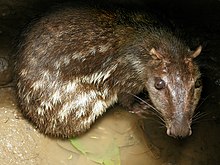Cuniculidae
| Paca | |
|---|---|
 |
|
| Lowland paca | |
| Scientific classification | |
| Kingdom: | Animalia |
| Phylum: | Chordata |
| Class: | Mammalia |
| Order: | Rodentia |
| Suborder: | Hystricomorpha |
| Infraorder: | Hystricognathi |
| Parvorder: | Caviomorpha |
| Family: |
Cuniculidae Miller & Gidley, 1918 |
| Genus: |
Cuniculus Brisoon, 1762 |
| Species | |
| Synonyms | |
|
For Cuniculidae:
For Cuniculus:
|
|
Cuniculus paca
Cuniculus taczanowskii
Cuniculus hernandezi
For Cuniculidae:
For Cuniculus:
A paca is a member of the genus Cuniculus of ground-dwelling, herbivorous rodents in South and Central America. It is the only genus in the family Cuniculidae. They are large rodents with dots and stripes on their sides, short ears, and barely visible tails. They are also referred to as "gibnuts" or "royal rats".
The Smithsonian Tropical Research Institute in Panama has studied the possibilities of developing the paca as a viable high-priced food supply for the tropics.
Pacas originated in South America and are one of the few mammal species that successfully emigrated to North America after the Great American Interchange 3 million years ago. They were formerly grouped with the agoutis in the family Dasyproctidae, subfamily Agoutinae, but were given full family status because they differ in the number of toes, the shape of the skull, and coat patterning.
Pacas are 50–77 cm (20–30 in) in length, excluding the 13–23 cm (5.1–9.1 in) short tail, weigh 6–14 kg (13–31 lb), and are the sixth-largest rodents in the world. Similar to guinea pigs, they have square heads, small ears, sides patterned with spots and stripes, and virtually invisible tails.
With large hind limbs, small fore limbs, and cone-shaped bodies, pacas are similar in appearance to the deer-like, ungulate chevrotains, and like them have four to seven horizontal lines of blotches and stripes along their flanks. They have a heavy and robust appearance, though their legs are long and relatively tiny. Their small ears are set high on their heads. They have four toes on their fore feet and five on their hind feet (of which two are short and hardly touch the ground) and they have stout nails that resemble small hooves. In young pacas, the skin is covered with horny scales about 2 mm (0.079 in) in diameter; perhaps these scales have a protective function against smaller predators. There is virtually no differences between sexes. They can live up to 13 years in the wild.
...
Wikipedia
